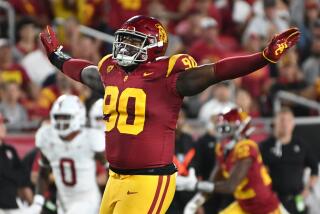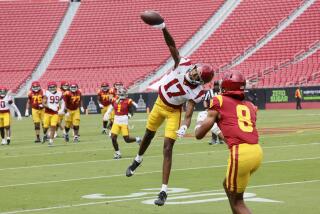SDSU Has Secondary Concerns : Going Deep Is the Way to Go Against Aztecs
- Share via
SAN DIEGO — After San Diego State’s 26-12 victory over Colorado State Saturday night, some reporters huddled around the locker of Aztec safety Harold Hicks.
There really wasn’t anything unusual about that, because Hicks often has been involved in key plays that have decided Aztec football games.
However, on many of those occasions, the key plays were a long pass or two, a missed tackle or two or a blown assignment or two. In other words, these were key plays in a negative sense.
Saturday was different. The reporters wanted to know about a key play that turned the football game around and sent the Aztecs on to a victory. This was an upset, since the secondary frequently has been singled out as the main reason why the Aztecs are a disappointing 4-7.
“We’ve taken a lot of heat this season, there’s no question about that,” Hicks said in the locker room. “But, finally, it feels good to talk about a big play for our side.”
The Aztecs trailed Colorado State, 12-10, early in the fourth quarter Saturday when Hicks was sent in on a safety blitz. Ram quarterback Scooter Molander rolled left, and Hicks came around behind him.
“I saw that he didn’t see me,” Hicks said, “so I used my windmill (motion with his right arm) to strip the ball.”
Hicks recovered the fumble and it was SDSU’s ball at its 28. From there, Todd Santos and the offense moved downfield for a score and an eventual Aztec victory.
“That (Hick’s play) was the momentum changer right there,” Aztec Coach Denny Stolz said afterward. “That was a big, big play.”
But that hasn’t happened much this season.
Which accounts for the questions Hicks and his secondary teammates usually hear after games:
--Why has one of last year’s strengths become a weakness with basically the same people?
--What has gone wrong back there?
Most of the season, the answer has been something like what safety Lyndon Earley said after an embarrassing 52-10 loss at Wyoming in early October.
“I don’t know what it is,” he said. “I don’t have a clue.”
Before the season started, San Diego State put out a media guide that featured photos of Santos on the front cover and photos of cornerback Mario Mitchell and Hicks on the back. Under each of the two defensive players, the caption read, “All-American candidate.”
Mitchell, a junior, was rated the third-best cornerback in the nation by The Sporting News and was nominated as a candidate for the Jim Thorpe Award, which goes annually to the nation’s top cornerback.
Both Mitchell and Hicks had started on the Aztecs’ Western Athletic Conference championship team a season ago, and they were joined by cornerback Clarence Nunn, a third returning starter. Expectations for 1987 were high.
“We made so many big plays in our defensive backfield last year that, of course, we expected to make a lot of big plays again this season,” said Tim McConnell, the Aztecs’ defensive coordinator. “Unfortunately, that just hasn’t happened.”
The Aztec secondary had 10 interceptions last year, compared to 5 this year. What’s more, opponents have passed for 2,688 yards in 11 games this year, compared to the 2,353 yards in 11 games last year.
It has reached the point where the secondary can’t even make a good play and get credit.
Against Cal State Long Beach, for instance, Nunn came under criticism for making an interception, of all things. Long Beach had a fourth-and-28 from the Aztec 45 when Nunn intercepted a pass inside the Aztec five. Had he knocked the ball down, San Diego State would have taken over at the 45.
“It’s been that kind of year, when sometimes it does seem that we can do nothing right,” Nunn said. “But, when you’re a defensive back, you have to learn to take the good with the bad. Unfortunately, we’ve had to take a lot of the bad this year.”
Said McConnell: “It’s a lot like being the quarterback. People don’t realize that the people in front of him have to play well for him to play well. The same goes for the defensive backs.”
Mitchell has learned that lesson this season. The way he sees it, he’s doing the same things he did last year.
“A lot of people don’t understand that when a guy catches a pass on you, sometimes it’s not just the corner guy’s fault,” he said. “Last year, we had some guys on the defensive line who just dominated the other offenses. That set things up for our secondary.
“This year, we haven’t got the same kind of pressure and it’s been tougher. I don’t want to sound like I’m blaming anybody else, but I’m just saying that that has something to do with it.”
McConnell agreed: “They (the secondary) are the ones that everybody sees. So it always looks like it’s their fault. But our pass rush hasn’t been as effective as it was last year, and we don’t have the same kind of linebackers who were real active and excelled at pass coverages (like) last year.”
And they don’t have Steve Lauter, the starter at strong safety a year ago.
“Maybe Steve was more of a stabilizing factor than we realized,” McConnell said.
Lauter’s absence has created some problems. For one, Hicks was switched from free safety to strong safety, and he has never really picked up the position and performed the way he did last year.
“I do my best to play there because that’s where they wanted me to play,” Hicks said. “But I guess I haven’t done enough.”
With Hicks removed from the free safety spot, the Aztecs inserted Earley, a sophomore. He started for most of the season but was replaced in the starting lineup last week by Casey Copeland.
“You would like to put your finger on one thing that has happened,” McConnell said. “But it’s just not really possible. A combination of a lot of things has had to happen.
“But the thing I’ve liked is that our kids have hung in there and continued to work hard. They don’t understand why they haven’t done as well as they would have liked, either, but we’ve tried everything and they’ve tried everything.”
Last week, in fact, they all went back to the basics. How far?
“The coaches were saying stuff like, ‘This is a ball,’ ” Nunn said, laughing. “But, we did go back to the beginning. And it helped. We didn’t do anything too confusing and we just tried to make (Colorado State) earn everything they got against us.”
The Rams did gain 222 yards passing but were unable to throw for a touchdown. In fact, the Aztecs have not allowed a scoring pass in three of their last four games. In all, SDSU has allowed 16 touchdowns through the air, the same number it allowed last year.
“I think all of us had in our minds at the beginning of the year to go back to the Holiday Bowl,” Mitchell said. “After we beat Utah (52-34 in the second game of the season), I thought we were going to be able to put it together. But then we went up to Air Force and got embarrassed (49-7), and for some reason we never got it back.
“It’s been difficult, but I don’t think any of us has ever doubted our ability as players back there. We all know that there isn’t a defensive back in the world that hasn’t gotten beat.”
Aztec Notes
Linebacker-defensive end Kevin Maultsby (sprained ankle) and fullback Kevin Macon (sprained knee) will not play against New Mexico Saturday, SDSU trainer Don Kaverman said Thursday. Running back Ron Slack, who missed last week’s game because of a thigh bruise, has been cleared to play, Kaverman said. But Slack said he was not sure he can play after testing his injured leg this week in practice. Defensive end Mike Hooper (sprained toe) and defensive tackle Brad Burton (stress fracture) both should be available to play, Kaverman said. . . . The planned 1988 season opener against Air Force, scheduled for Saturday, Sept. 10, at San Diego Jack Murphy Stadium, may be moved because of a scheduling conflict with the Padres, Athletic Director Fred Miller said. The Padres are scheduled to play weekend day games against the Atlanta Braves. Miller said the Air Force game would be moved either to the evening of Sunday, Sept. 11, or to Saturday, Sept. 3.


